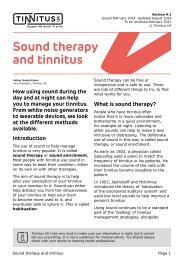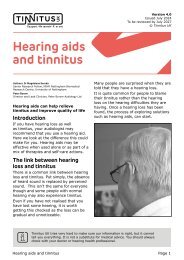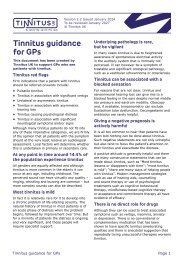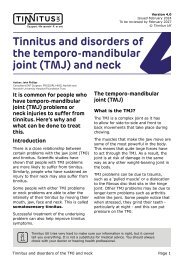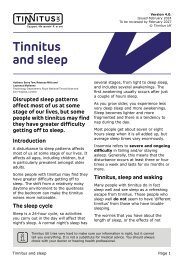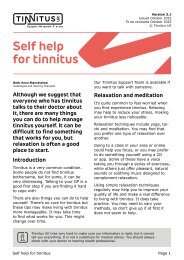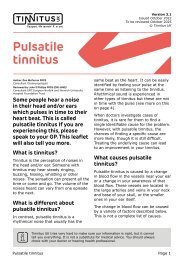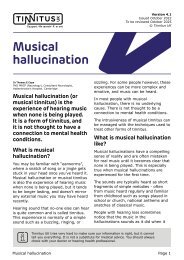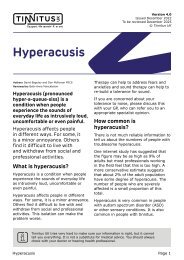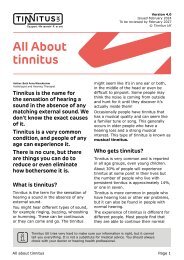Time to listen: A manifesto for tinnitus
Three steps the Government must take to give people with tinnitus hope for a cure
Three steps the Government must take to give people with tinnitus hope for a cure
Create successful ePaper yourself
Turn your PDF publications into a flip-book with our unique Google optimized e-Paper software.
Young academics need to be inspired and nurtured to commit their future career to
this important area of research. A series of workshop events should take place in
universities with a hearing loss specialism in order to communicate what a growing
and interesting field this is, with the opportunity to do life-changing work.
The existing research community, which has achieved so much despite limited
funds, also needs to be utilised and educated on how to maximise their chances of
securing larger funding grants for tinnitus research. Talented researchers who are
at a transition point in their careers and who have the potential to be future leaders
should be encouraged to apply for a Fellowship. The field could also be grown if
researchers were to tie applications in to areas already recognised as strategic
research priorities, such as living brain research by the Medical Research Council
or by building tinnitus research into studies around multi-morbidities. However, it is
important that initial studies remain focused on establishing the key foundational
knowledge of tinnitus that years of underfunding has caused.
3. Prioritise studies that will help establish the key foundational knowledge for
tinnitus research, and enable the community to move forward to find cures,
including:
a. Identifying tinnitus biomarkers
b. Developing reliable objective measures of tinnitus
c. Identifying tinnitus subtypes
The gross underfunding of tinnitus research has resulted in big gaps in
foundational knowledge that must be made a priority if cures are to be found.
Identifying biomarkers and objective measures would enable clear diagnoses
and offer the potential for researchers and medical professionals to judge whether
particular treatments are working. This would have a huge knock-on effect in
attracting both the pharmaceutical industry and researchers and so needs to
be a key priority.
Being able to identify the different subtypes of tinnitus would enable more
targeted research and reduce the dead-ends that can occur when a seemingly
promising treatment is found to not work with a certain group of people or certain
individuals.
A Tinnitus Biobank that builds on the excellent work done by the UK Biobank would
aid with subtyping and also provide a route to answer many of the other identified
challenges.
Putting steps in place to prioritise research proposals in these key areas would
enable the tinnitus research community, which has brought us to the edge of
great progress in the field, to build consensus and key foundational knowledge.
It would put it into the best possible place to do the important work needed to find
cures for tinnitus.
9




